Where: Zaragoza, Aragón, Spain.
When: Many times between 2018 and now
Why: Zaragoza is our second nearest ´big´ city, so we regularly visit here for quick weekends away or when we have visitors.
>->->->->->->->->->->->->->->->->->->->->->->->
Map

>->->->->->->->->->->->->->->->->->->->->->->->
Intro
One of the things that I’ve learned in life is that it’s great if you can have a ‘second city’ nearby; somewhere near you that you can escape to easily, just to have a break from where you live. It’s helpful if this city is also bigger than your hometown so you can access alternative restaurants, shops and delights that you cannot get at home. In the UK, my second city is Birmingham (Oh, I miss Brum). When we lived in South Korea our second cities were Seoul and Busan (Oh, I miss Seoul and Busan). Now, our second city has become Zaragoza.
Zaragoza, the capital of Aragon, is one of those cities that most foreigners will not have heard of – and yet it´s such a fantastic place. Located pretty much in the middle of nowhere (like, in the middle of a literal desert), in the middle – between the Med and the Atlantic coasts, close to no other big cities, Zaragoza often gets forgotten about – and yet it is a fantastic place to visit. There´s loads of history here, things to see, parks, shopping, restaurants and nice hotels. Zaragoza is an excellent destination for a weekend, city-break.
Zaragoza is located on the Ebro River, the main tributary in Spain. The area was first settled by ancient Iberians and then later on the Roman Emperor Augustus built a city here – called Caesaraugusta (how did he come up with that name?). There are extensive Roman remains throughout the city – mostly around the main square (Plaza de Nuestro Senora de Pilar), including a harbour, theatre, baths and a forum (more about this below).
During the Arab conquest of Spain, Zaragoza became the capital of the Ebro area of Al-Andalus. The Palace of Aljaferia was built during this time. It now houses the Aragonese parliament but you can visit it (more about this below).
Zaragoza suffered two sieges during the Peninsular (Napoleonic) Wars. The sieges were particularly brutal. Over 50,000 citizens and 30,000 troops died defending their city (I just cannot imagine such horrific figures!). I´d like to know more about this period of history but so far I haven´t been able to find out a lot about this time. I think the city museum might have more information about this but we haven´t made it there yet.
The main sight in Zaragoza, and the centre of the city, is the Basilica of Our Lady of the Pillar. Our Lady of the Pillar refers to Mary, mother of Jesus, and it is thought that this basilica is the first church that was dedicated to her. (Many Spanish women are named Pilar, named after Mary.) According to local tradition, St James was preaching in the Iberian peninsular and was feeling fed up, so Mary appeared to him as an apparition and gave him a column of jasper and a wooden statue, which he was to build a church around, dedicated to her. This church was later destroyed but the people of Zaragoza kept the pillar and the statue. Many churches have since been built on this site (this is also the heart of the Roman city), on the banks of the River Ebro, but the current Basilica was built in the 1600s – and it is magnificent! The colourful, geometric roof, the cupolas, the golden stone and the sheer scale of this building are so eye-catching. It really is the heart of the city. (More about this below).
Anyhoo, so what I´m trying to say in this preposterously long introduction is there´s many things to see and do in this vibrant city and it is well worth a visit.
>->->->->->->->->->->->->->->->->->->->->->->->
Getting There
Plane
Zaragoza has a nice, modern airport with basic facilities. There are direct flights from here to London Stansted with Ryanair.
Bus 501 runs between the airport and Delicias train and coach station and Paseo Maria Agustín, which is close to the Aljaferia Palace.
If I was trying to get to downtown Zaragoza I would change buses at Delicias Station and jump onto bus 38, which goes to the old town.
The airport bus currently costs €1.85 (Aug 22). You can get more information from the official Zaragoza public transport website (in Spanish but pretty obvious how to use).
Train
The main station in Zaragoza is Delicias – a huge edifice located in the north-west of the city, away from the centre. It´s a transport hub which combines the city´s train and coach station. To be honest, I´m not a huge fan of Delicias station as it´s too huge and airy, and a little bleak, but it does have cafes, a sweet shop and an Ale-Hop shop – and usually we pass through pretty quickly.
Bus 51 and 38 run from the train station to the city centre. The local buses currently pick you up from the back and drop you off at the front. A single ticket is €1.40, which you can buy on the bus, or you can buy a rechargeable pass from any Tabac shop, which reduces the fares to 70c or so.
Zaragoza Delicias has high-speed trains to Barcelona and Madrid, both of which are about two hours away. You can also get direct trains to Pamplona, Vitoria, San Sebastien and other cities to the west.
There are three other, smaller train stations in Zaragoza (Miraflores, Goya and Portillo).
Two cool regional train lines start in Zaragoza, both of which I´d like to travel one day. The first is the service which runs from Zaragoza to Canfranc Station, which is the stupendous, famous, ´deserted´station, up in the Pyrenees, near the French border. (I´ve been to the station but travelled there by car, not by train). This line runs through Huesca and past the dramatic rock formations at Mallos de Riglos.
The other regional line, which I´d like to take one day, is the train which runs down through the empty centre of Spain, from Zaragoza to Valencia, via Teruel (which is rumoured to not exist, it is so isolated). The journey takes five hours and would probably be pretty boring, in a very relaxing, watch the world go by kind-of way.
You can get train times and book tickets, in English, at the Renfe website.
Coach
Zaragoza coach station is in the same building as Delicias train station. You can get coach information at their website.
>->->->->->->->->->->->->->->->->->->->->->->->
Getting Around

Zaragoza has a good tram and bus network.
Trams are run by Transvias Zaragoza. You can find route and ticket information, in English, on their website. You can usually buy tickets from machines on the platforms, or you can use a travel card which you can buy in Tabac shops. A single ticket is €1.40. A journey using a travel card is 76c – and with these you can transfer to other transport. You have to validate your ticket or card when you get on to the tram.
To be honest, we haven´t used the trams as public transport as we´ve always stayed in the centre, but on our last visit we used the trams as an attraction for our little boy, who was three at the time. He loves trams and trains. We took him for a couple of rides on the trams as they were a nice, easy way to see parts of the city and we were able to find playgrounds further out. Riding the trams in summer could be lovely, as the air-conditioning would be nice in the high heat.
The bus network is pretty comprehensive and is embedded in Google maps, so is pretty easy to navigate. As with the trams, tickets are €1.40 for a single or you can use travel cards. You can buy tickets from the drivers and you don´t need exact change.
>->->->->->->->->->->->->->->->->->->->->->->->
What we did on our holiday



Basilica de Pilar
The key site in Zaragoza, the thing which dominates the skyline and draws the eye, is the huge Basilica de Pilar. Built of golden stone, with the colourful geometric roof, this golden edifice is a spectacular site to see.
As I said in the introduction, this current basilica was built in the 16/17/1800s. It´s a huge, golden building with a colourful, geometric roof, domes and towers (one of which you can go up).
On the inside, the nave is a huge open space, held up by large pillars. I´ve only ever visited the area at the far end (by the main entrance doors), which is where the holy chapel is, which houses the jasper column and wooden statue of Mary, that it is said were given by an apparition of Mother Mary to St James. There is a place behind the holy chapel where you can touch the pillar of jasper.
Many people through history have donated cloaks and jewels for the statue to wear and these plus other relics can be seen in the Basilica Museum. (Although according to the website this is temporarily closed – Aug 2022).
Around the holy chapel are the roofs which have frescoes painted by Goya. They are very pretty. You can pay a small amount to get lights to shine on the frescoes so that you can see them better. It didn´t work when we tried though.
You can go up one of the towers in an elevator to get views of the roofs and the city (Torre Mirador del Pilar). If you are looking at the basilica from the main square, this is the back left tower (I´m pretty certain you enter from outside the building). It costs €4. I haven´t done this yet, but it´s on my list of things to do next time we are back. You can get opening hours and up to date prices, in English, at the Cathedral website.
Roman ruins
Between 25 BC and 11 BC ish, Roman emperor Octavian (a.k.a Caesar Augustus) founded a city, here on the banks of the River Ebro, called Caesaraugusta. The city was based around the forum, which was in approximately the same place as the basilica and main square are today. The remains of the forum have been excavated and you can see these at the Forum Museum (Museo del Foro de Caesaraugusta), which is underneath Plaza de Nuestro Senora de Pilar. The museum is located at the end of the plaza, by the Goya statue, in a building which looks like it is made out of stained glass stones.
There are two parts to the museum. In the one section you can walk among the old Roman walls and sewers and the other section has exhibits of Roman artifacts that have been found here, including lots of Roman pots, sewer lines, decorations etc.
So, on my first visit to Zaragoza we visited with my friends and grandparents – and they visited the museum. They came back raving about one thing in the museum – the lift. This is going to sound really silly, but the lift is really cool! It´s a big pole that rises out of the ground, like something out of a sci-fi movie set. Luckily for me, when I later got to visit the museum I was heavily pregnant – so the guide very kindly let me use the lift so I didn´t have to navigate all the stairs – and it was really cool and now here I am raving about it too.
Anyhoo, my favourite part of the museum (apart from the lift) was the show about the city´s history, told from the perspective of the River Ebro itself. I´m sorry, but I just couldn´t stop laughing I found this so funny. The show I saw was in Spanish and English and involved projections and the River Ebro voice over. It was interesting but a little long. I also liked it because I got to have a nice sit down.
The website for the museum is in Spanish but is pretty easy to understand. A ticket just for the museum is €4 or you can buy a ticket for all of the Roman sites for €7.
The other key Roman sites, which I´ve not gotten to yet, are the theatre, baths and the harbour. These are all located in the city centre. There is also a large Roman wall at the end of Plaza de Nuestro Senora de Pilar.
Goya Gallery
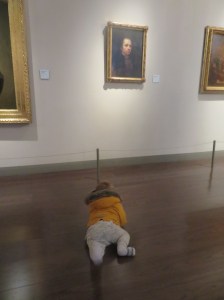
I once was the production assistant for a film shoot of the Francisco de Goya train, a sleeper train which used to run from Paris to Madrid, via northern Spain. The train was named after the painter, Francisco de Goya – one of Spain´s old masters.
Francisco de Goya is famous for his life-like portraits and his drawings of the atrocities of the Peninsular Wars. He was born in Fuendetodos, Aragón, a village about 40km south-east of Zaragoza.
There is a gallery of his work in Zaragoza, located just off the main square and in here are many of his paintings and drawings, and also art which was contemporary to him. I really like Goya´s portraits, which often have a real warmth to them, but what I most enjoyed in the museum were his comic like drawings, showing life as it was in Spain in his day and age.
We took my toddler here too, who was two at the time, and I also had a lot of fun chasing him as he crawled around the galleries (not). Luckily, most of the visitors seemed to think he was extremely cute rather than annoying.
That is all. Wikipedia can tell you more about Goya; find out more about the gallery and book tickets (in English) at their website. Normal entry is €6.
Aljaferia (UNESCO)
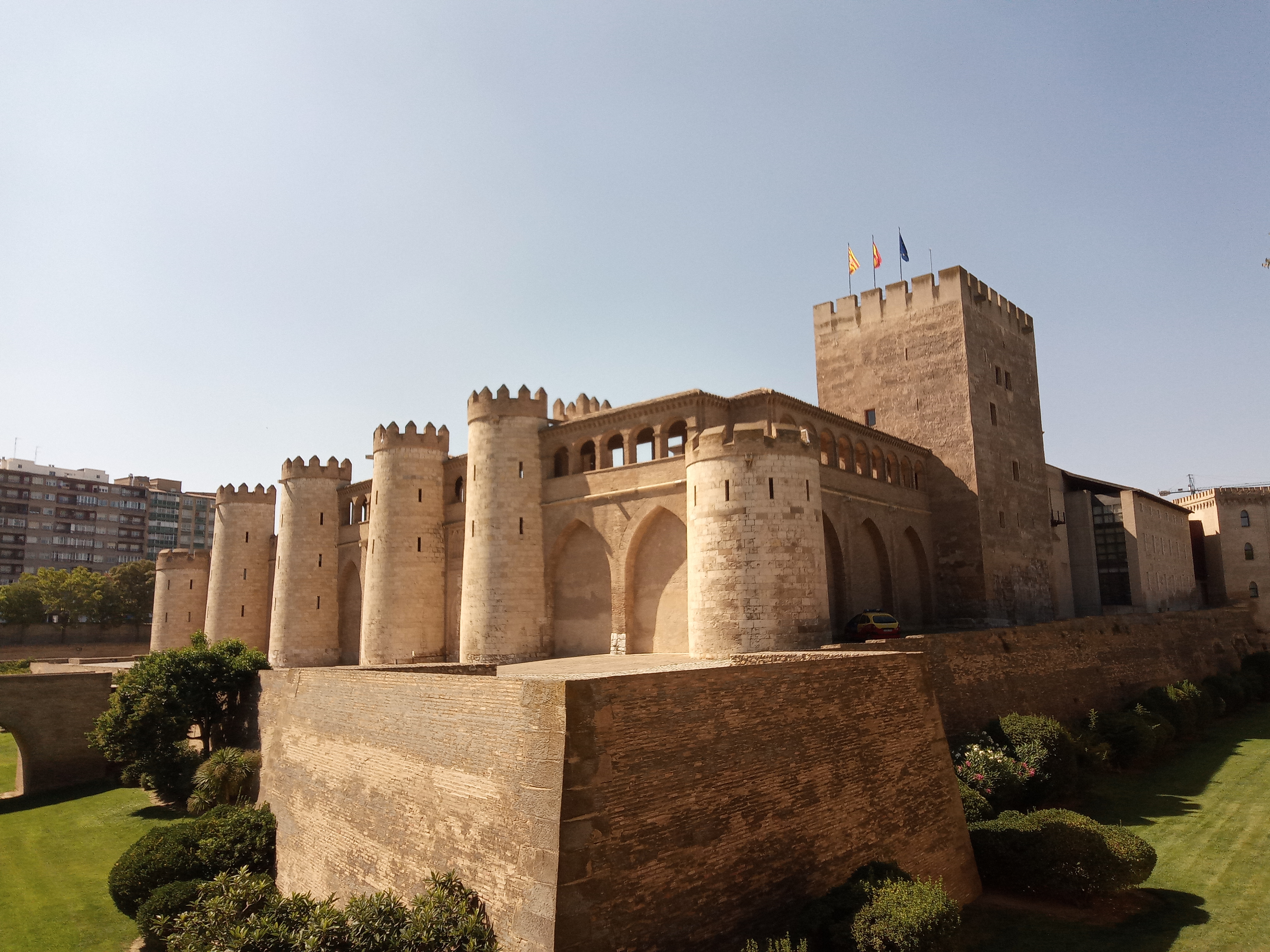



I´m really fascinated by Spain´s Arabic history, but it´s not something that I´ve been able to find out a huge amount about. I´m especially interested in the Arab history in the north, where we live; I think because I find it hard to associate this colder, damp land with, what I think of as desert people. I always associate Andalucia (Al-Andalus) with the Umayyad conquest of the Iberian peninsular, but in fact Al-Andalus stretched all the way from the south to just north of Pamplona – and right across to the tip of Galicia. Only the very north was not invaded.
Obviously the key sites for this era are the palaces in Granada, Cordoba and Seville – but Zaraoza also has a stunning Moorish palace, although it is much less famous than the other sites.
The Aljaferia is a castle/palace that was built in the 10th century. In the late 15th century, after the reconquest, the palace was expanded to be a Palace for the Catholic Monarchs. Today it is the Cortes, the Parliament of Aragon. You can find out more about the history of the building at Wikipedia.
Outside, the Aljaferia looks like a proper desert castle, built of golden stone and made up of big walls and a cluster of strong, straight towers. Inside, the main building is a delicate balance of light and air, with lace-like columns holding up arches around a refreshing green, central garden. The meeting rooms are well decorated, many with ornate, patterned ceilings. It doesn´t have the razzmatazz of the Alhambra, but it´s still a very pretty building. It feels like it´s still a working palace – which it is.
I visited the Aljaferia in September 2021 and at the time I had to pre-book my ticket online. I don´t think that´s the case now, though you can still book online if you want to, at their website (in English). The Cortes Aragon (Aragon Parliament) website has useful information (in English) about visiting times. My ticket cost €5 and my unguided visit lasted about an hour. I enjoyed my visit here as the building is stunning, albeit slightly empty. I´d have liked to know a lot more about the history of the people who lived here, not just the building. For example what important events took place here, who lived here, what were their stories? I´d like to know more.
Directly around the palace is a moat and some very high, very dangerous walls. I sat on a low rise wall by the ticket office to wait for my visit time, I turned to look at the castle, and nearly fell off the wall in shock at the huge! drop directly behind me. I have heart palpitations at the thought of my toddler climbing over these walls.
Around the Aljafira is a huge park, which contains a couple of playgrounds. This is where my family waited for me. (Thanks guys).
Fire station museum



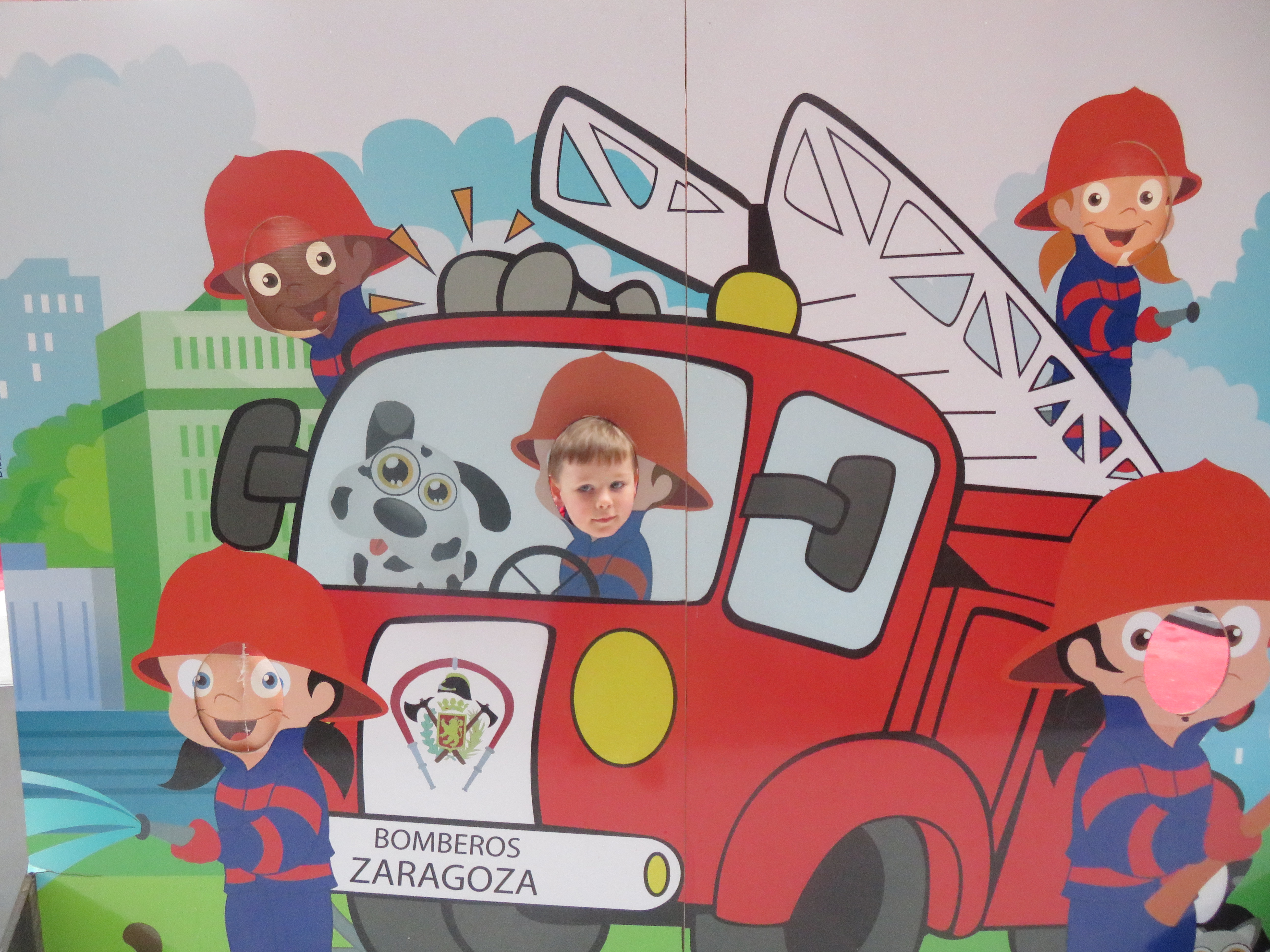
What do you do with a toddler on a city break? They´re not quite old enough for most museums, they´re not interested in history, shopping or eating. It´s quite hard finding things that they´ll enjoy. Luckily for us, the fire station museum was right by our hotel and our toddler loves nee-naws, so we spent a wonderful hour or two here.
The museum is located in an old monastery and in the central courtyard there are lots of old fire engines, one of which you can climb into. My favourite was the 2CV fire engine. There are also displays of fire-fighting equipment and information about the largest disasters Zaragoza has suffered, which the fire-fighters have attended (fascinating if a little macabre). There was a cinema, which they very nicely turned on just for us, though sadly my son at the time had the attention span of a three-year old, so unfortunately we didn´t actually get to watch anything. There were also cool dioramas / models of tiny fire engine scenes, which my son loved.
The best thing about the museum though was that they were so friendly! They gave my son fun guides and walked us around to show us where everything was. There was also a collection of free second-hand books in the entrance hall, so we got some goodies.
They have lots of activities for kids, though these are probably more appropriate for slightly older children, so I´m sure we will be back.
An adult ticket was €3.20; under 8´s can visit for free. More information can be found on their website.
Market (Mercado Central)
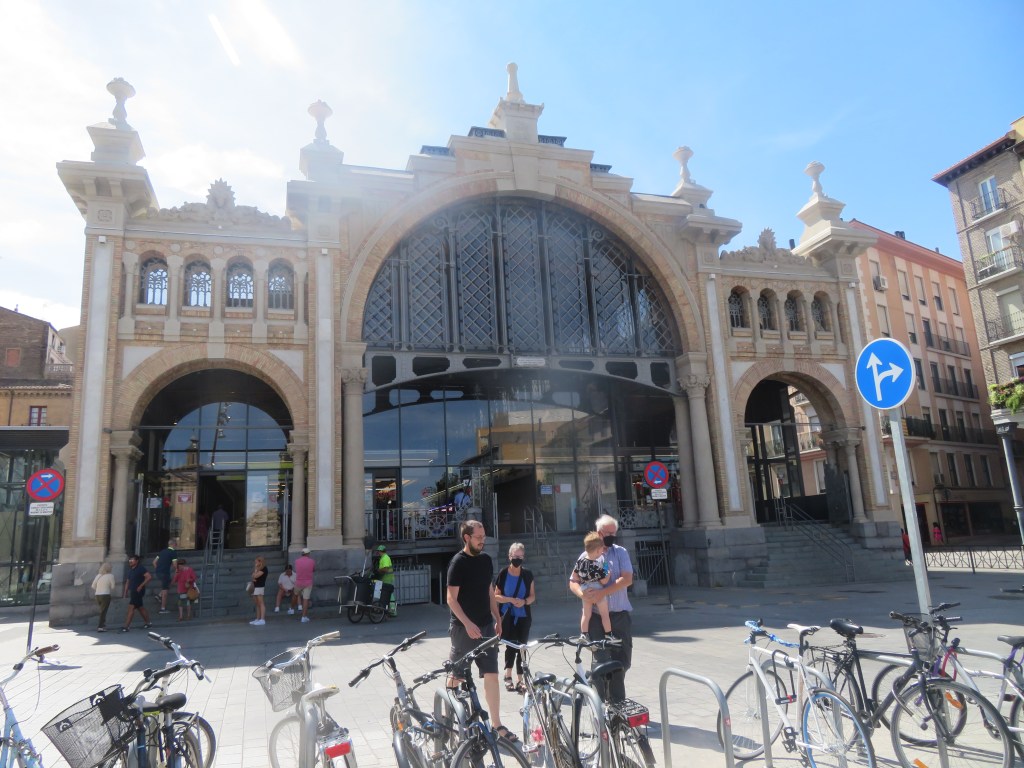
The central market is located in a beautiful, open-airy structure – that looks slightly like an ornate train station (see above). The market hall was originally built in 1895 and was renovated recently (it reopened in 2020). It has 74 stalls, mostly selling food products. I wouldn´t spend a huge amount of time here but it´s a lovely place to have a look in and it´s very central. Apparently the bread is very good.
www.mercadocentralzaragoza.com
Shopping
I wouldn´t say Zaragoza is the best for shopping, but this is definitely something I like to do every time we go there. I love to pop in to the Taste of America shop, which sells lots of interesting American products; C and A, as we no longer have one in Pamplona and the Re-Read bookshop as I like to see what second-hand English books they have. Most of the shopping is along P.º de la Independencia. There´s some great touristy, trinkety shops on and just off Calle de Alfonso 1 too (this is the road that runs down to the Basilica de Pilar).
Also to mention are the Torre Outlet Mall, which I´ve not made it to yet, but would like to stop by. This mall has big name brand outlet shops. You probably need a car to get here. www.latorreoutletzaragoza.com.
There´s also Gran Casa Mall, which is on the other side of the river to the town centre, but which is on the main tram line (green), and which Jeff took Santi to as it has an amazing playground. It also has lots of high-street shops, so I might go there with them next time. www.grancasa.es.
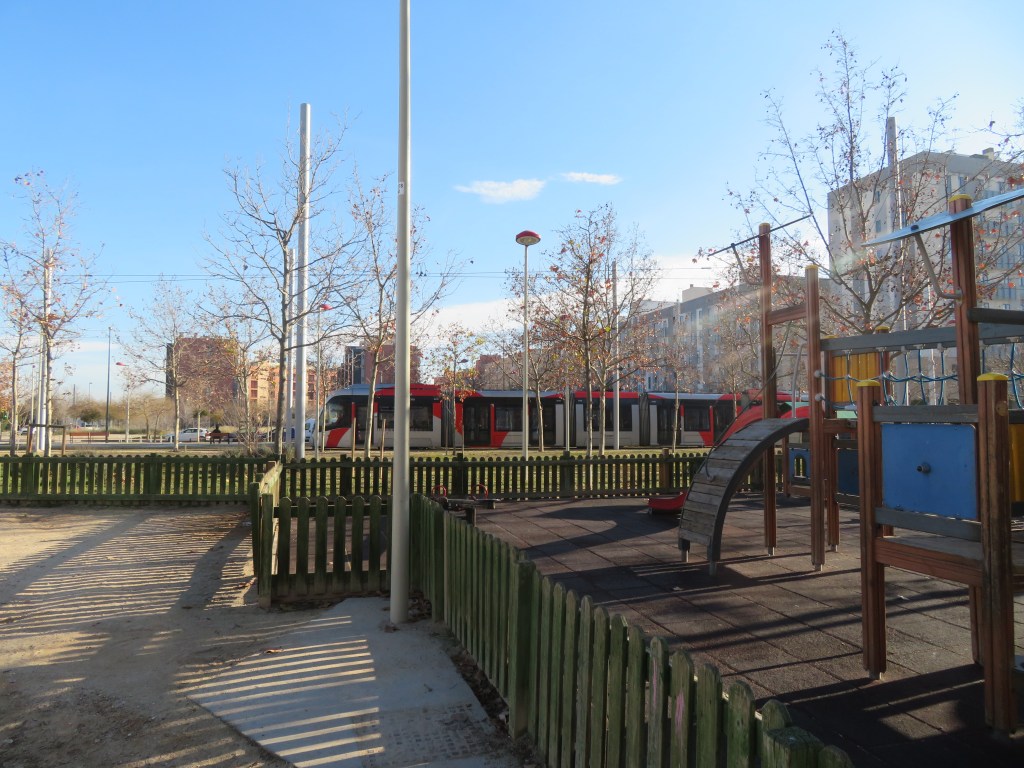
Playgrounds
We have a toddler, so most trips involve a playground at some point. As I said above, Jeff took Santi to an amazing playground in Gran Casa Mall and we also visited some playgrounds in Parque de la Aljaferia. We took the tram out of the city and we found a pretty cool playground in Plaza San Fransisco. We then walked back to the city centre along the promenade in the middle of Passeo de Fernando el Catolico and there were a few small playgrounds along here.
Ride the trams
As I said in the Getting Around section, the trams actually became an attraction for us, something easy to do in the very hot and very cold weather. Travelling on the trams with our little boy was a relaxing, cheap way of seeing more of the city and he enjoyed riding the trams. We always got a seat pretty quickly, and it was interesting getting out of the centre. We took the green line out to Los Olvidados, where we got off as we spotted a cool playground – and then we went back again.

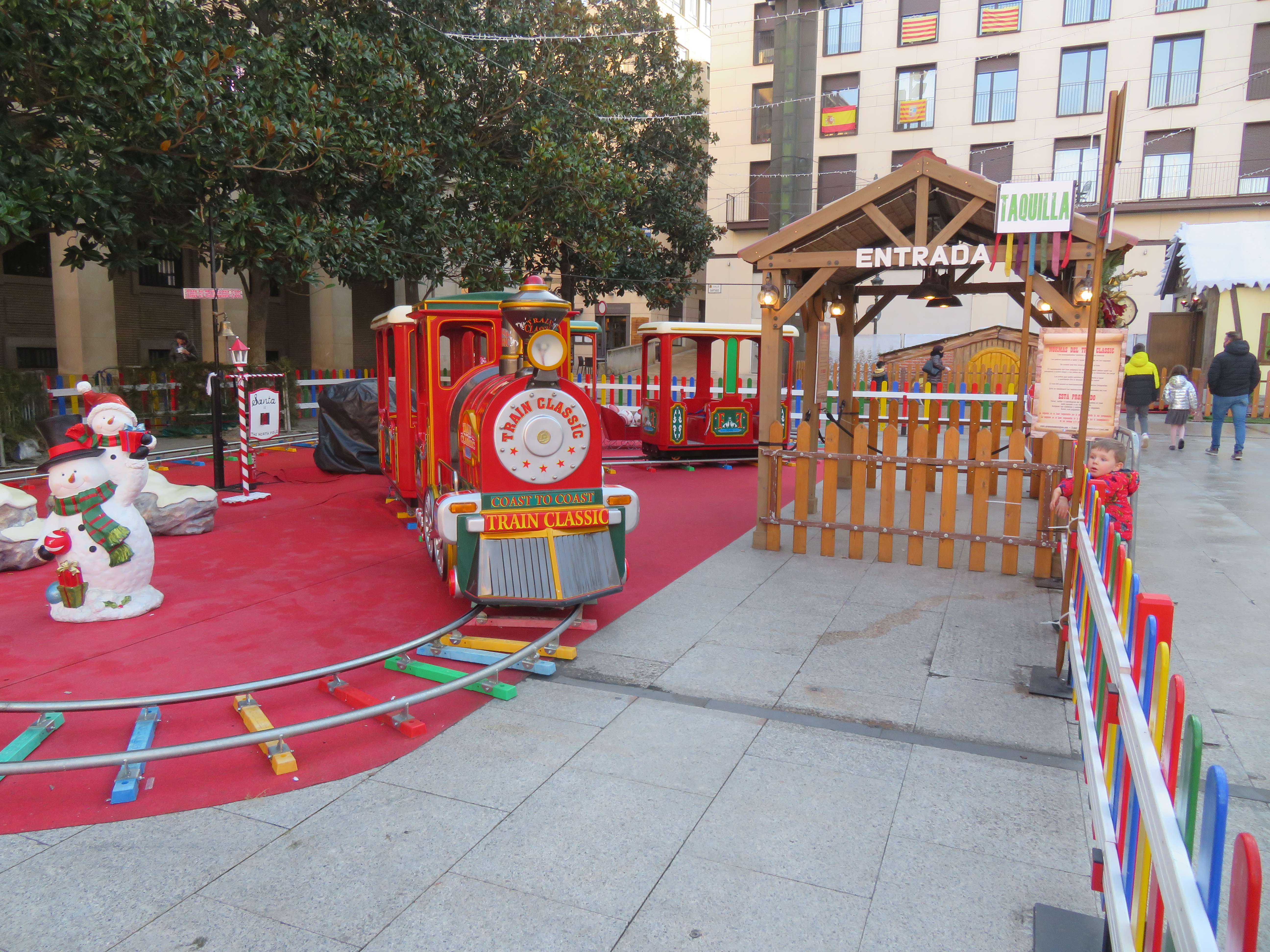
Christmas Market and fair
We visited Zaragoza in Twixtmas 2021 and there was a wonderful Christmas market and small fair outside the Basilica, by Hotel Pilar. The market had stalls selling trinkets and local delicacies (yummy churros) and the fair had a merry-go-round and a small train. My son loved these. There was also an area with statues of the nativity that you could walk around.
What we didn´t do
La Seo Cathedral (UNESCO)
Although stupendous and enormous, the Basilica del Pilar is actually just a co-cathedral in Zaragoza. The other cathedral is La Seo. La Seo, a.k.a. The Cathedral of San Salvador, a.k.a. The Cathedral of El Salvador, has UNESCO world heritage status because of its Aragonese Mudéjar decorations.
Many religious buildings have been built on this specific site. Construction of the current cathedral began in 1140, but from what I understand it is a hodge-podge of different styles, from different eras, and also incorporates some of the mosque that used to be located here. Wikipedia can tell you more about this.
It costs €7 to visit the cathedral, plus €1 to climb the tower. Opening times and current prices can be found on the cathedrals´ website.
Also inside La Seo cathedral is the Tapestry Museum.
The cathedral is located in Plaza La Seo, which is the bit at the end of the main plaza where the Roman Forum Museum is.
The Church of San Pablo (UNESCO)

Located on the other side of the tramway tracks, to the west of the main plaza, is the Church of San Pablo: “The most valuable testament of the Mudéjar style in Zaragoza” according to España website. This is why it has UNESCO listed status. The original building dates to the late 13th century, but this has been added to and modified over the years. It has an octagonal brick tower (see photo).
The ZGZ website has information about the church, in English.
La Lonja
Beautiful commerce / exchange building built in 1600s. Now an exhibition space for the city, but I think you can still pop in just to have a look. Located at the far end of Plaza del Nuestro Senora del Pilar (by the Goya statue). Free entry. www.zaragozago.com/palacios-zaragoza/lonja.
Museum of Zaragoza
Containing Roman mosaics and Goya painting, the Museum of Zaragoza is focused on the history and art of the city. I´d like to visit here as I´ve heard they have information about the sieges, which I´d like to know more about.
Entrance is free. The museum is open from 10.00 to 14.00 and 17.00 to 20.00 (closes at 14.00 on Sundays).
Natural Science Museum
River Aquarium
Located up towards Delicias Station, the River Aquarium contains over 5,000 animals from five different representative rivers: The Nile, Mekong, Amazon, Murray-Darling and Zaragoza´s own Ebro.
The website is only in Spanish, but if you click on the big Green Compra tu Entrada button, which is in the top right corner, you can buy tickets online. An adult ticket is currently €16, children aged from 5 to 12 are €10 and 3 to 4 year olds are €4. I couldn´t find anything on their website about opening hours, but according to Google Maps they are open from 10.00 to 20.00 each day.
Guided Tours
ZGZ run a range of interesting guided tours, including tours about the siege of Zaragoza, history tours, food tours and a Mujedar tour. I´ve just discovered them while writing this page and I´m very tempted by a couple of their tours, so if I go on one next time we are in Zaz – I will update the page and let you know how it goes.
Information about the tours can be found (in English) on their website. General ticket price is €5.50.
Pablo Gargallo Museum
I´ve never heard of him but he has his own museum so he must be famous. Pablo Gargallo (a.k.a. Pau) was a sculptor and painter, who lived around the end of the 19th century. He was friends with Picasso. Wikipedia can tell you more about him in English and The museum website can tell you more about the museum. His museum is in the old town, in Plaza de San Felipe, which is a nice place to grab a drink.
Origami Museum
6 galleries of Origami. €3. www.emoz.es (English).
Festival of Pilar
Zaragoza´s festival is on the 12th October, which is also the National Day of Spain. It lasts for nine days. The female patron saint of Spain is commemorated with an abundance of flowers.
>->->->->->->->->->->->->->->->->->->->->->->->
Where we ate and drank
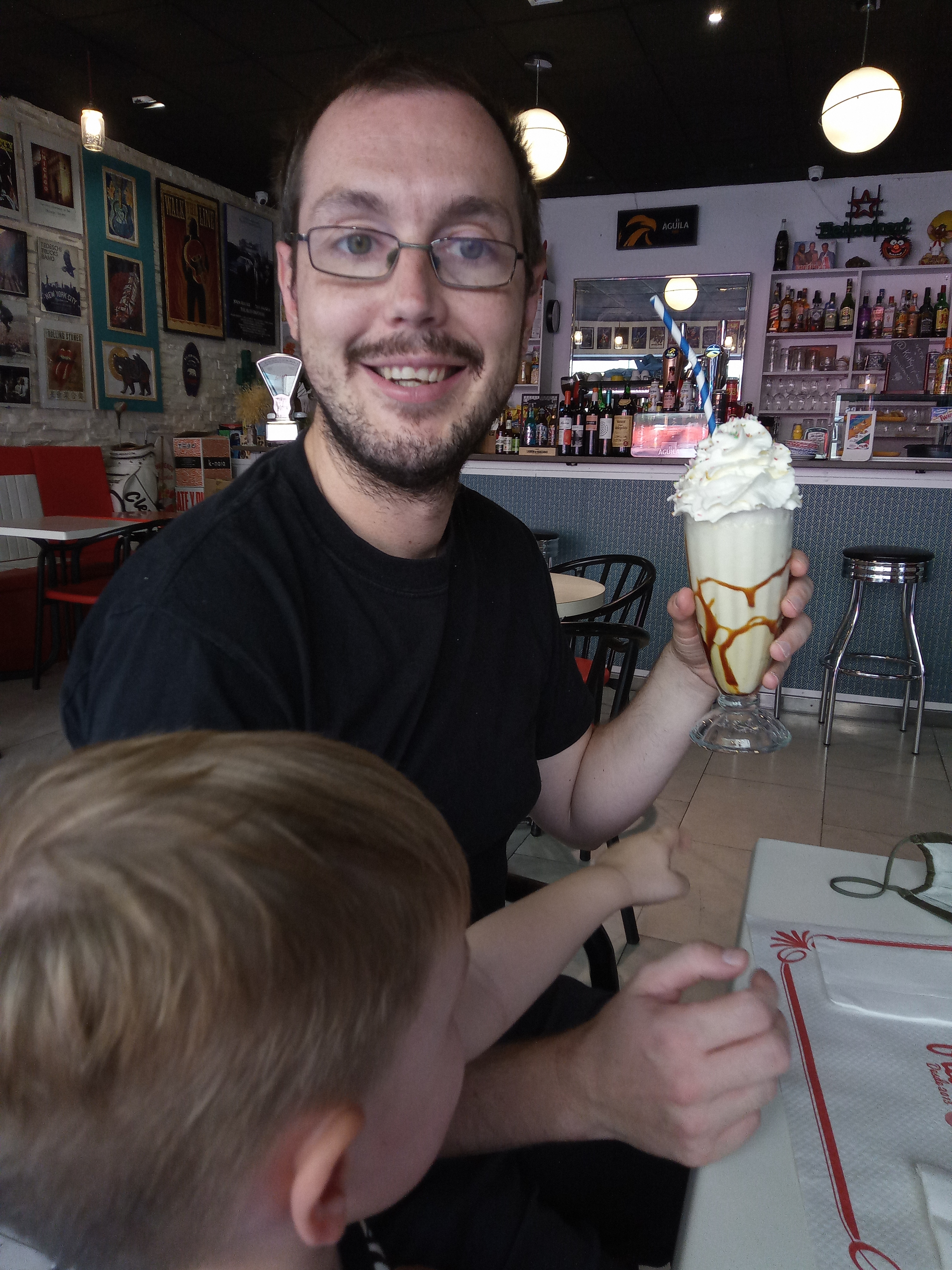
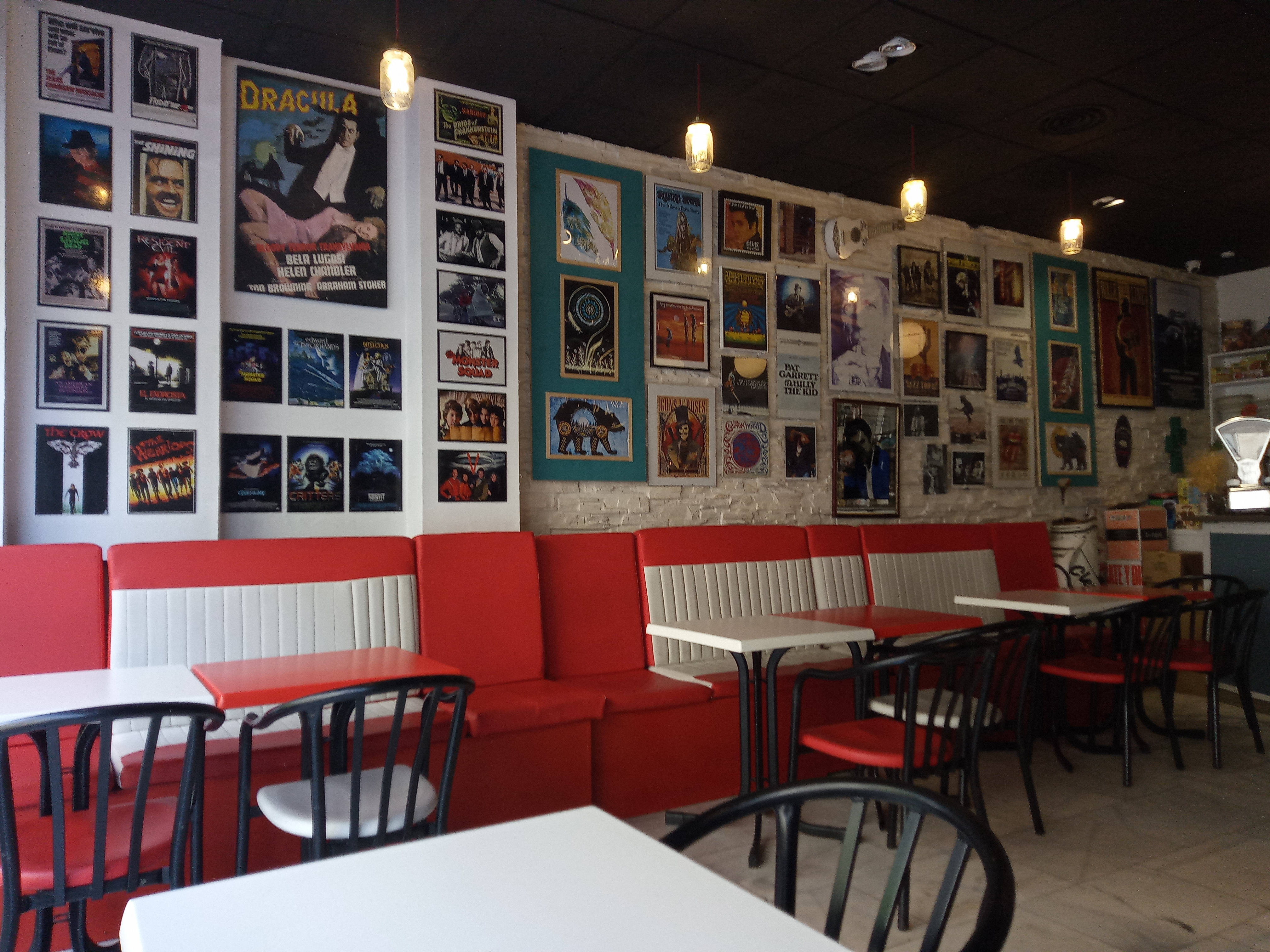
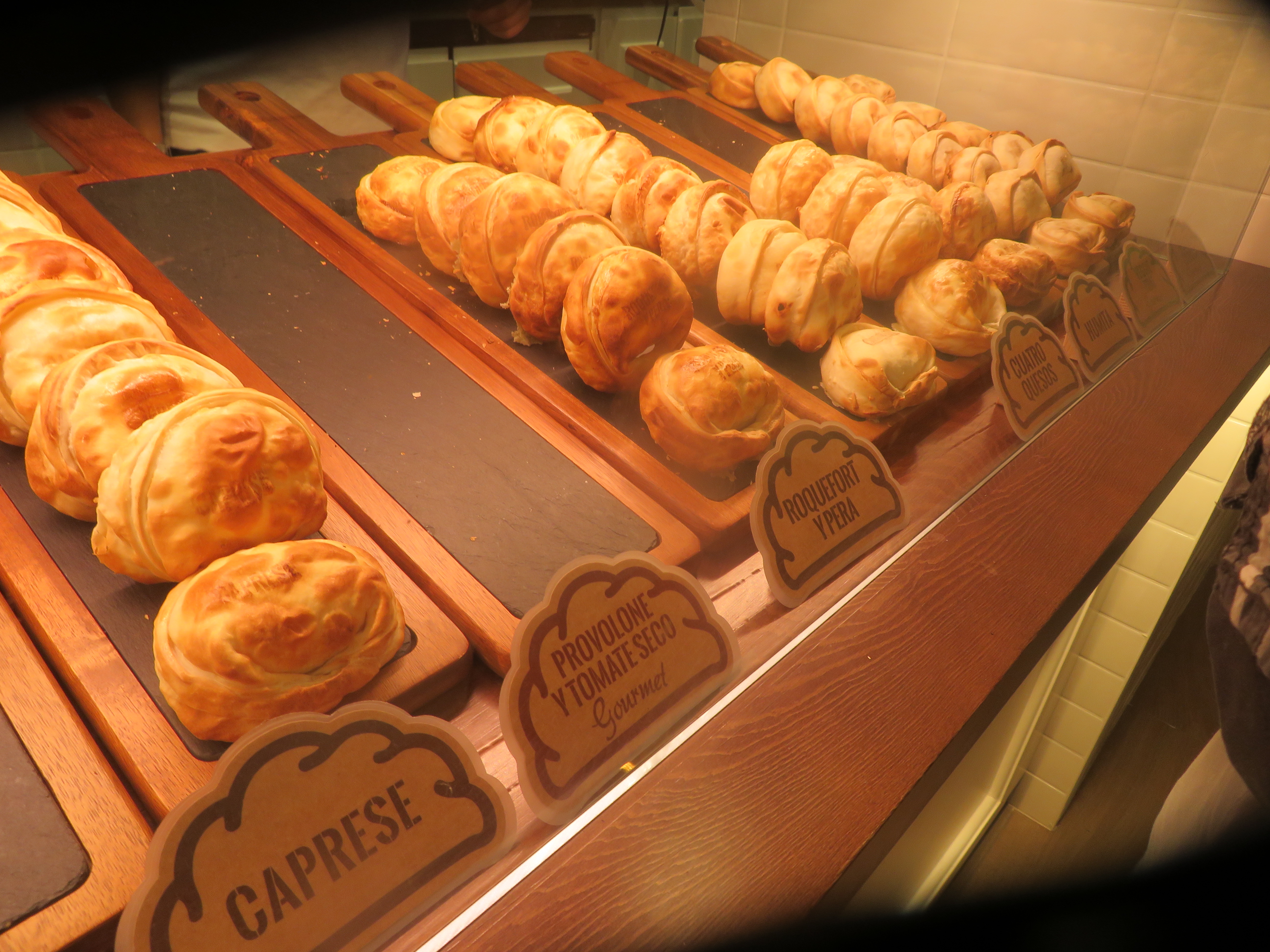
The famous area is El Tubo, an area of small alleyways where people go to bar hop and eat tapas. This is located between Mártires, Estébanes and Cuatro de Agosto Streets, in the central area of the old town. España has more information about the area. I also enjoyed having a drink and people watching from the tangle of tables at Plaza de San Felipe in the old town, though the drinks here were a little expensive.
One the things we love about Zaragoza is that there are so many restaurants with vegetarian options. Our favourite is Birosta, which serves vegetarian and vegan burgers, sarnies, pizzas, toasts, chips, salads etc and amazing deserts (their Banofee pie is wonderful). With three vegetarians in the family, this place is perfect for us because everyone has choice and can find something they like to eat – which is often not the case in Spain. birosta.com.
We also love that there are more international food options here, so we often head to Zaz just to eat and drink food from around the world.
We enjoyed going to Kuky´s Place, an American diner which serves burgers, hot dogs and amazing milk shakes, all named after films and celebrities (The Samantha Fox burger is quite funny). You can see the menu on Globo and find out more about the place on their Facebook page.
I also enjoyed snacking on Argentinian Empanadas from Empanada Malvon, which is located at the end of Calle Alfonso.
ZGZ offer guided food tours, including a chocolate tour which I may have to book. They also have a guide to eating and drinking in Zaragoza.
>->->->->->->->->->->->->->->->->->->->->->->->
Where we stayed
Palafox
We booked to stay at the Palafox for our babymoon (a holiday, just the two of us, pre-baby). It´s wonderful, in a 1960s/1970s luxury kind of a way. The rooms were nice, but the features were definitely very dated – but I liked this. There was a sign outside our door which lit up if we were in the room; I seem to remember there was a huge mirror above the headboard and the decorations were quite 1970s.
The staff were extremely helpful and friendly, the hotel is very central and we had a fun stay here. There is an outdoor pool on the roof, but as we visited in October, this was closed. It tends to come up for about €80 per night out of peak season.
Pilar
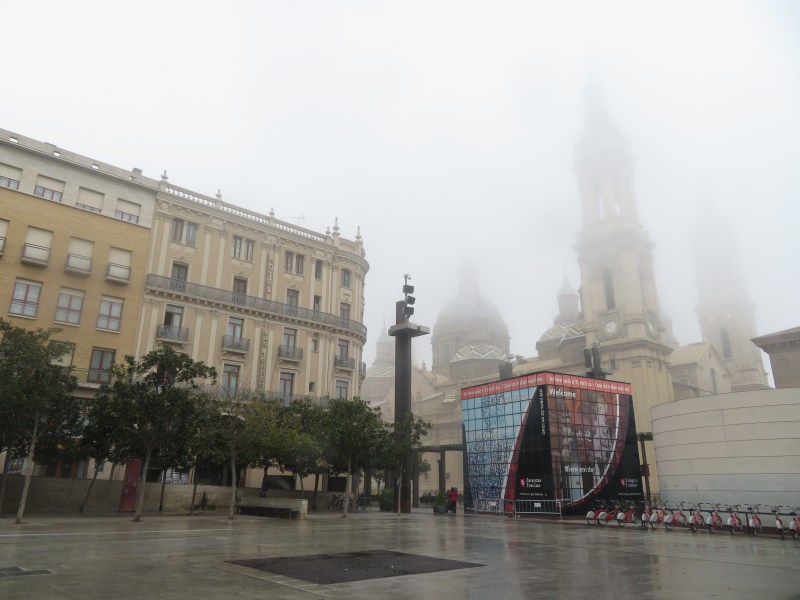
Possibly the best located hotel in Zaragoza, the Pilar is on the main square, overlooking the Basilica. In fact, my lovely parents who I stayed here with, were given a huge corner room, overlooking the square and the cathedral. The views were amazing but they said it was a little noisy at night.
I´ve also got to give kudos to the Pilar because they very kindly have let me use their bathrooms, even when I wasn´t staying there and they didn´t know I was a previous guest. Thank you Pilar.
We stayed here in February 2019 and our room was okay but it was a little worn. For example we had one of those really cool showers with lots of different water jets, but a few of them weren´t working and we´d have just preferred a normal shower. However, these were just little things and we´d definitely stay here again.
We paid €70 per night for a double room.
Alfonso
The Alfonso is a hotel with a very central location. It has a wonderful roof-top pool with views overlooking the city. (I sometimes think I see the pool in adverts.) We visited when many COVID restrictions were still in place, so we had to book times to use the pool, but we really didn´t mind. It meant we had the pool mostly to ourselves and we had a fun time splashing in here with our toddler and his grandparents.
The room we had was spacious and the bathroom lovely. The best thing about it though was the electric blinds, which we had far too much fun opening and closing, like we were in a sci-fi movie.
We stayed here with our toddler and they provided a cot. Our room was about €80 per night (Sep 2021).

INNside

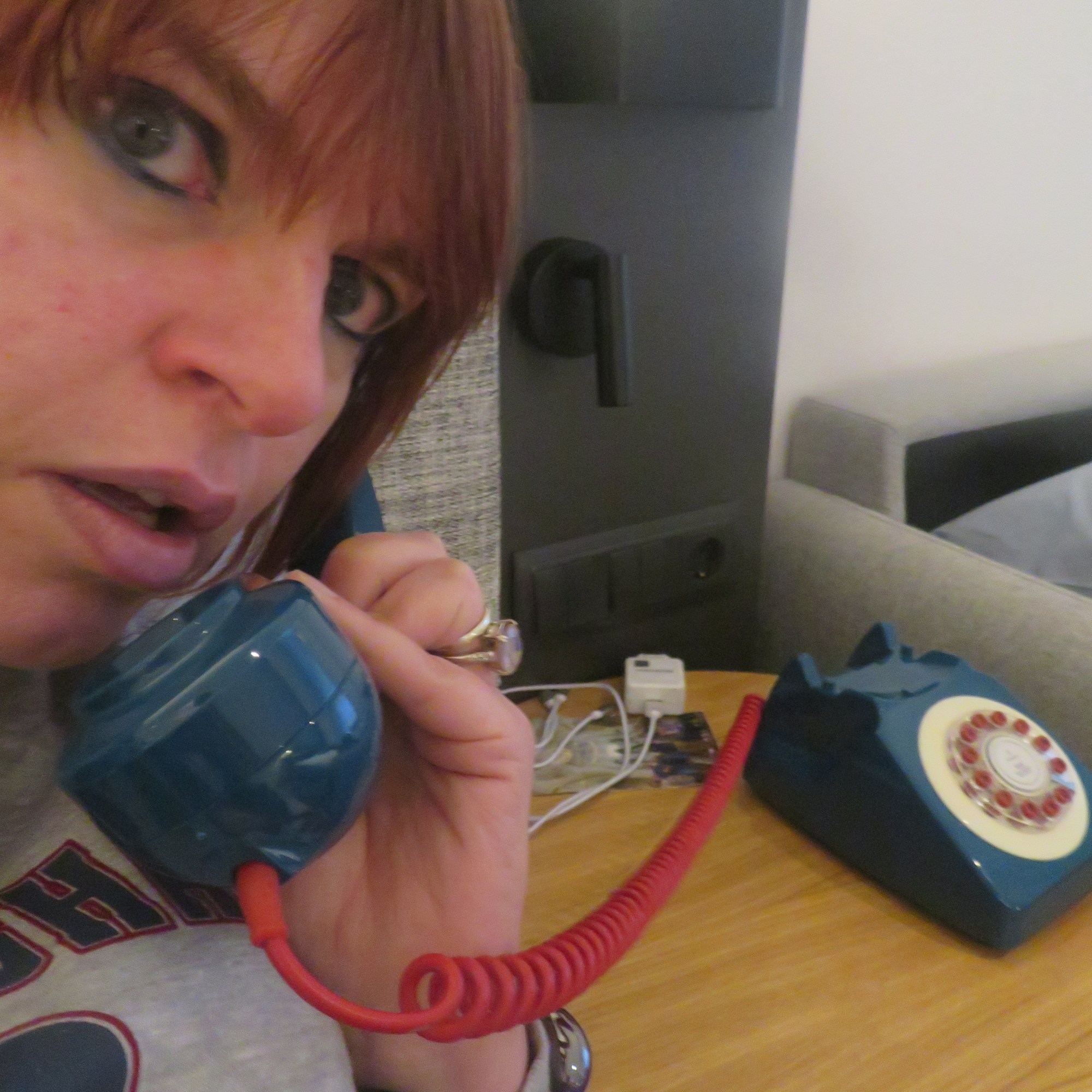

The INNside is one of my favourite city hotels. It has the best shower for sure, nice products, fun accessories in the rooms and you can tell they have thought about everything a traveller might need. We stayed here for a two nights in early January 2022, and our room was a lovely, snuggly den for the three of us. It was comfy, fun, easy to be in and very central. We liked that we could cast our shows from our phones to the TV (and TVs in other rooms if we´d wanted to), it had a fridge and coffee making facilities and it had one of the best hotel showers I have ever experienced, and the products were wonderful.
I thought I might find it a bit pretentious, as there are yoga mats in the room and it´s very trendy – but it actually was a really nice place to stay because it was so unbelievably comfortable.
We paid about €80 per night (January 2022), which I think this place is worth. In high season, prices seem to be much, much higher. We had a double room and our son had a fold out bed – which was really comfy. I know as I´m the one that ended up in this, while he used the big bed.
They have a very cool, outdoor pool, on the roof. Hopefully we´ll definitely stay here again and get to use it.
The INNside is part of the Melia chain. You can find out more about the hotel on their website.
>->->->->->->->->->->->->->->->->->->->->->->->
Useful links
The best website I´ve found for information on visiting Zaragoza is the Zaragoza tourism website (ZGZ), which as well as having extensive information about what to see, do, eat and drink in the city, also has suggested tours, including maps. www.zaragoza.es/sede/portal/turismo. In English.
www.spain.info/en/destination/zaragoza
www.lonelyplanet.com/spain/aragon-basque-country-and-navarra/zaragoza
Disclaimer
Please note, some of this information may not be correct, or may be out of date. All these articles show is how we found these places when we visited and what we personally thought of each place. Where possible I will include links to sites which contain more up-to-date information. All of this is our own work and any opinion expressed is that of the author only.
All photos copyright of J Clemo-Halpenny, unless otherwise stated. If you would like to copy or reproduce any of these images, please email me to ask permission.

2 comments